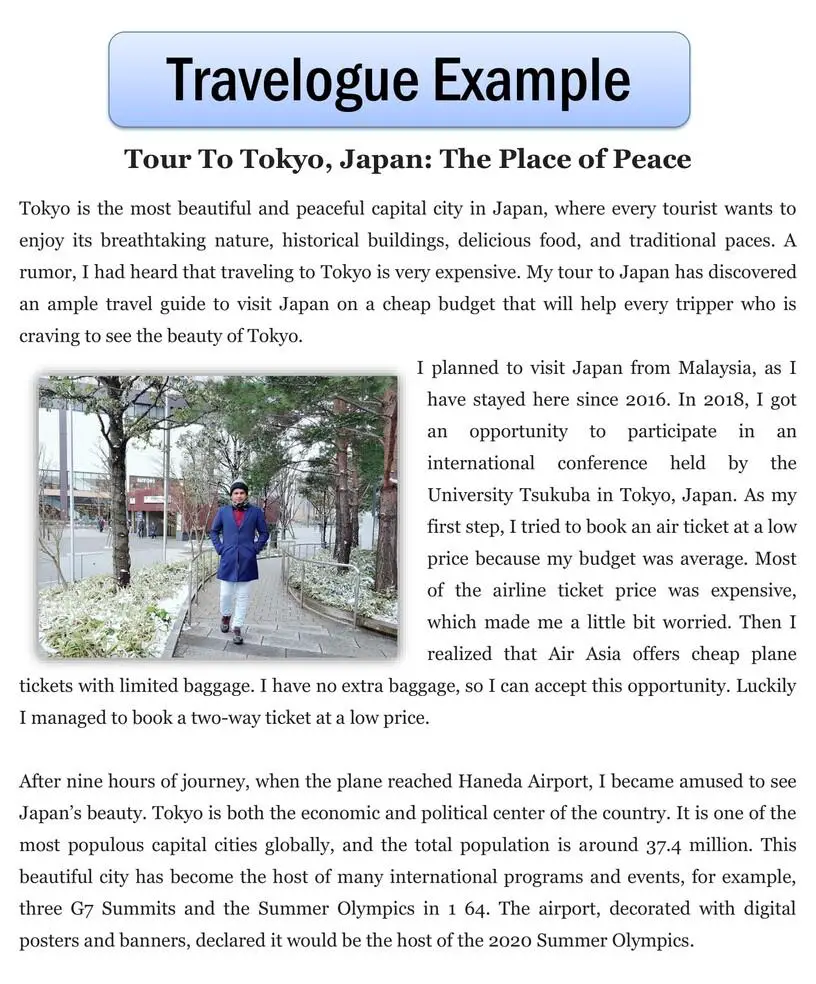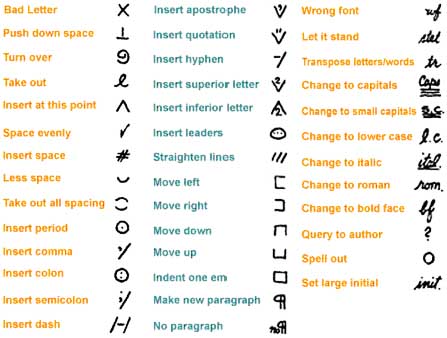Travelogue Feature Article Examples & Sample For Students- Tour To Japan. Short and Long Travelogue Feature Article Writing Examples For Students.
Travelogue Article
Travelogue article refers to the feature story writing that explains the traveler’s tour guidelines. It is also known as a travel feature story writing in journalism. Journalists write travelogue articles to inform others about tourist spots. A travel feature article is always designed to ensure a hassle-free journey to a particular location like a travel itinerary.
The most common feature articles are profiles, how-to, reviews, and travelogue articles. Travelogue article is a crucial feature in journalism for recreation and entertainment. The writer follows the inverted pyramid of writing style to attract readers. Readers always read the headlines and story leads to decide whether to read the whole article or leave it. Therefore, the headlines and feature leads include how, where, and what to explore.
People travel for various perspectives: recreation, business, job purposes, multicultural immigration, curiosity, and adventure.
Elements of Travelogue Article
The Ten Elements to write a travelogue article are:
1. Visit and explore the place
2. Write a descriptive story
3. Explain how to travel to the destination
4. Discuss the hotel, motel and accommodation
5. Review the cultural and traditional background
6. Explain the historical and tourist attraction
7. Discuss the food and restaurant
8. Notify the weather and atmosphere
9. Report the shopping mall
10. Mention the Dos and Don’ts fact.
Travelogue Feature Article Example for Students
The two examples of travelogue feature articles have been illustrated for students. The first example represents a long history and the second example illustrates a five-day short travelogue article. These travelogue examples are suitable for those students who want to write a travelogue article.
The title of the long travelogue article is “Tour To Tokyo, Japan: The Place of Peace.” A journalism student at the University of Putra Malaysia wrote this article. Students may follow the structure of this article to know how to write a long travelogue article.
The author presents an ideal travel feature article example for students that includes most components of the travelogue article.

A Long Travelogue Feature Article Writing Example -1
Tour To Tokyo, Japan: The Place of Peace
Tokyo is Japan’s most beautiful and peaceful capital city, where every tourist wants to enjoy its breathtaking nature, historical buildings, delicious food, and traditional paces. A rumor, I had heard that traveling to Tokyo is very expensive. My tour to Japan provides a comprehensive travel guide to visit Japan on a cheap budget that will help every tripper enjoy Tokyo’s beauty.
I planned to visit Japan from Malaysia, as I have stayed here since 2016. In 2018, I participated in an international conference at the University of Tsukuba in Tokyo, Japan. As my first step, I tried to book an air ticket at a low price because my budget was average. Most airline ticket prices were expensive, which worried me a little bit. Then I realized that Air Asia offers cheap plane tickets with limited baggage. I have no extra baggage so I can accept this opportunity. Luckily I managed to book a two-way ticket at a low price.
After nine hours of journey, when the plane reached Haneda Airport, I became amused to see Japan’s beauty.
Tokyo is both the economic and political center of the country. It is one of the most populous capital cities globally, with around 37.4 million. This beautiful city has become the host of many international programs and events, for example, three G7 Summits and the Summer Olympics in 1 64. The airport, decorated with digital posters and banners, declared it would be the host of the 2020 Summer Olympics.
Japanese are very kind, humble, helpful, and polite. I perceived it during the conversation and asked for help from them.
Per my pre-planned, I decided to stay with my friend instead of at a hotel. He lives in the Akabane area, which is around 30 kilometers far from the Haneda International Airport. So, I was looking for a station to get the train to Akabane. I asked a Japanese police officer to help me find the train station to take me there.
I became amused to see his hospitality; he had taken me to the exact location where I could get the train. He also paid money for my ticker because of not have Japanese currency. The tickets cost ¥1400, and the journey takes 5 minutes. Finally, he bowed to exchange greetings when saying goodbye to me. It is a tradition in Japan to bow while exchanging greetings.
I caught the last train from Haneda Airport Terminal 3 Train Station, and after 55 minutes, I arrived at Akabane station at 11:45 AM. My friend was waiting for me outside the station, wearing an anti-cold jacket, which amused me. I felt freezing whenever I came out of the station; because this area was not under air- conditioning. Instantly, I removed my jacket from my baggage and put it on to protect myself from the bitterly cold weather. I have always been afraid of the cold, but I enjoy the cold weather in Japan.
It was ten minutes’ walking distance from my friend’s house, so we started to walk, and finally, we reached our destination at 12:30 PM. It was the second time I was astonished that my friend had not locked his house. For my curiosity, I asked him why not lock his house when getting outside. He replied that there is a rare house robbery incident in Japan, even though you leave your houses without locking them.

The following day, I woke up early to prepare and participate in a conference held by the University of Tsukuba. This is the first time I have fallen in love with the beauty of Japan to see the fantastic weather. It was freezing weather with windy and falling snow. This was my first experience of seeing snowfall. I dreamed of experiencing this kind of atmosphere that I had only seen in the cinema.
My habit is capturing photos; therefore, I grabbed some pictures inside and outside the station. Now I know how to purchase a ticket using the ticket machine that the Japanese police officer taught me last night. I bought my ticket to get to the University of Tsukuba.
I joined the APEC- Tsukuba International Conference XIII, and they offered a buffet lunch for all participants. There was no doubt that this conference paved the way for me to be connected with academic life in the future. The university appointed a few guides to ease our movements in new places. The guide took us to a restaurant to have lunch. It was my first opportunity to test Japanese food. I thought I would not feel comfortable eating Japanese food when I saw them on the table. My concept turned reversed when I tried them. These foods were very delicious, and everyone enjoyed them.
Most of the food items were preferable to me, except raw eggs. Japanese restaurants provide raw eggs, and many Japanese and foreigners eat them. I stopped eating in the meantime, having lunch to think whether the foods were halal or not. I asked the guide for confirmation, and he replied that these foods were perfectly halal. He also said that all restaurants in Japan are not halal, so Muslims should be more aware of having food in Japanese restaurants.
The obesity rate in Japan is higher than in other countries; therefore, they set different prices for the same food for lunch and dinner. Usually, they set the dinner food price higher to discourage people from having heavy food at night.

Figure 2: Traditional Japanese Restaurant
The gift-giving etiquette is another ritualistic and meaningful custom in Japan. They offer gifts on many occasions; for example, they provide many traditional gifts for all participants at the conference. Nobody can deny the cordial hospitality offered by the University of Tsukuba. Along with me, all the participants from diverse countries became glad and praised them. They are treating us very politely. I became confused several times when I thought about how they attacked Pearl Harbor in 1941 in the United States. It seems Tokyo is the world’s most secure and peaceful capital for living without the hassle.
I decided to rest for the third day because I was exhausted. We spent the whole day together inside the house, gossiping, cooking, and eating. In addition, we planned to roam around Tokyo the next day. I have to return to Malaysia in two days, so I need to plan to see all the best places in Tokyo within two days. We divided Tokyo City into two zones for visiting them in two days.
On the fourth day, my friend and I followed the train to visit SKYTREE, the tallest tower in Japan, located in Sumida, Tokyo. It costs only JP¥450 and takes around 30 minutes from Akabane station to Oshiage Station (SKYTREE), but it needs to change the platform two times. Since 2011, it has been the tallest structure in Japan, extending its height to 634.0 meters and making it the second tallest tower and structure globally, after the Canton Tower and the Burj Khalifa. The primary objective of using this tower is broadcasting; for example, they use it for TV signals and radio waves for national broadcaster NHK and a few numbers TV channels.
Every day they allow only 10,000 tourists to visit the sky tree. The ticket option is divided into three types: combo ticket, Tembo gallery, and Tembo deck. The ticket is around JP¥10 00 for all three tiers. Tourists can visit only one or two, or all three decks. My excitement was palpable when I was lifted to the top floor of the Sky Tree. We had seen all three tiers—the tower’s appearance changes with changes in a light color.
My tour to Japan was successful when I saw Tokyo from the Tembo Deck and the tower’s top floor. Viewing the entire city from the top floor at night was excellent. After all, I did not forget to buy some souvenirs from the observation levels of Tokyo Sky Tree; it made my journey more compelling.

Figure 3: The Main Entrance of the Tokyo Skytree
Good time flies so fast. It was challenging to realize that I had spent five days here. My return flight schedule was at night; I made it to utilize the whole day sightseeing. On my fifth and final day in Japan, I visited many historical and traditional places, such as the Imperial Palace, the Sensō-Ji Temple, the National Museum of Nature and Science, and Ueno Park and Zoo. In addition, I tested Japanese street food; although these are a little bit expensive, some foods are cheap.
You can buy souvenirs, gifts, and food cheaply in many places. I purchased pens, gift items, and great souvenirs in Asakusa on Nakam Street. It’s a great street to visit and walk along your path to see the traditional temple, and along the walk, you can buy snacks and conventional gifts. Japanese people are well organized and always respect the senior people in every sector. Traditionally, seniority acted as the prime qualification for holding a higher rank.
In short, Tokyo is not an ordinary place that I forget quickly. According to Japanese “architect Tadao Ando “Look at London or Paris: they are filthy. You don’t get that in Tokyo. The proud residents look after their city.” Traveling to Tokyo was a tour and an experience I earned adequately. I can forget my tour, but I cannot forget my experiences. So, if you love traveling, you will love Tokyo!
Travelogue Article Samples of the Newspaper
Malaysian English Newspaper Travel Article Link
The Daily Star Newspaper Travel Article Link Here
This is a travelogue article writing example for Students. This travelogue sample will help students to complete travel articles writing assignments and expand their knowledge. We appreciate your comments and suggestions.
